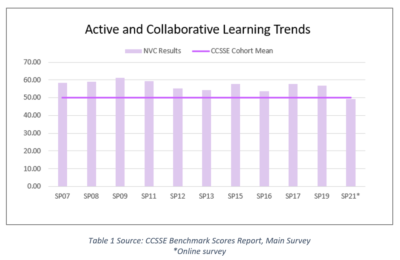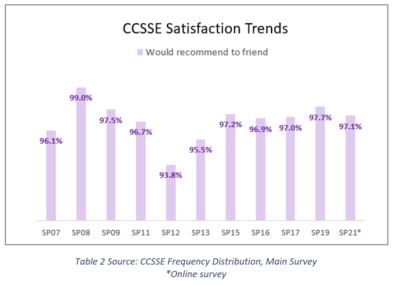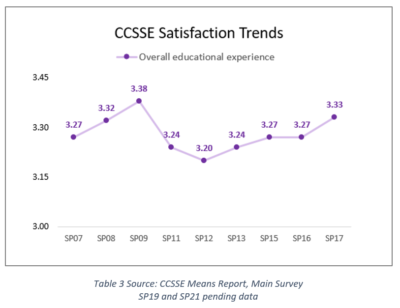The CCSSE (pronounced as “sESSie”) is a national survey of community college students that focuses on their academic engagement while in college. The Department of Institutional Research, Planning, and Effectiveness (IRPE) administers the survey for NVC biannually during the Spring semester in selected college-level courses. To determine which courses will be chosen to administer the survey, CCSSE selects a random sample of college-level courses, stratified by course start time in order to increase representation of part-time students.
WHY do we administer the CCSSE?
Results from the CCSSE help us understand students’ classroom experiences and academic habits. We can use this information to track a range of factors that contribute to student success. Administering the CCSSE makes us part of a three-year national cohort, which gives us access to comparative data from all other colleges in the cohort. We can also compare our data with subgroups of the cohort, including colleges of similar size, other Hispanic-serving institutions, and our sister colleges in the Alamo Colleges district.
HOW does it work?
CCSSE measures student engagement through benchmarks, which are groups of correlated questions that each relate to a specific marker of student engagement. Behind each benchmark is research supporting it as a best practice in education. The questions that measure each benchmark reflect educational practices research has shown are positively related to student learning and persistence. CCSSE standardizes benchmark scores around the mean of the cohort, allowing us to compare our results easily.
The five CCSSE benchmarks of effective educational practice in community colleges are active and collaborative learning, student effort, academic challenge, student-faculty interaction, and support for learners.
WHAT have we learned?
Because of NVC’s consistent administration of the CCSSE, we have trend data on the benchmarks that goes back to 2007. Analyzing this trend data can give us a picture of the ways we have been engaging students in effective educational practices. For example, our CCSSE scores indicate active and collaborative learning has consistently been an important part of student engagement at NVC. Our results for this benchmark have been higher than the national CCSSE cohort for all but one year we administered the survey. The only time we dropped below the CCSSE cohort mean was Spring 2021, when we were still fully remote and had an unusually low response rate to the online survey.

The survey questions that measure active and collaborative learning ask students about their academic habits outside of class as well as what they do in their classes. Below are the CCSSE questions correlated with active and collaborative learning:
Item 4: In your experience at this college during the current school year, about how often have you done each of the following?
4a: Asked questions in class or contributed to class discussions
4b: Made a class presentation
4f: Worked with other students on projects during class
4g: Worked with classmates outside of class to prepare class assignments
4h: Tutored or taught other students (paid or voluntarily)
4i: Participated in a community-based project as part of a regular course
4r: Discussed ideas from your readings or classes with others outside of class (students, family members, co-workers, etc.)
In addition to the benchmarks, there are two questions that are used as a measure of NVC’s institutional effectiveness. Data from these items are often reported at convocation and in various internal and external reports:
Item 26: Would you recommend this college to a friend or family member?
Item 27: How would you evaluate your entire educational experience at this college?
Together, these questions represent one measure of student satisfaction with NVC. Analyzing changes in responses to these items can alert us to the need to do more research into students’ experiences in order to discover where there might be feelings of dissatisfaction. The following tables show trends for these two questions across our administration of the CCSSE.


WHO does it serve?
The ultimate goal of CCSSE administration is to gather data that will help us better serve our students. Although it is not a complete picture, we can use the survey in combination with other measures to help us understand the student experience at NVC.
CCCSE results can also help you and your college area. You can view results from past administrations of the CCSSEon the IRPE AlamoShare page to determine if your unit can use results in your area for planning or assessment purposes. To access the AlamoShare page, when prompted enter your username as NVC\username and use your workstation password.
If you are interested in discussing how IRPE can help your unit use data for research, planning, and assessment, reach out to an IRPE team member.
Eliza A. Hernandez, Ph.D.
Director of Institutional Research, Planning, & Effectiveness
Petra Ortega
IT Data Analyst
Deborah Font
Coordinator of Measurement and Evaluation
